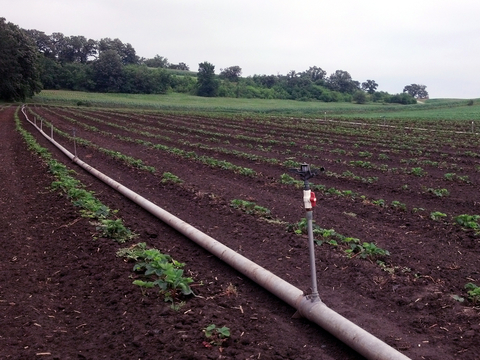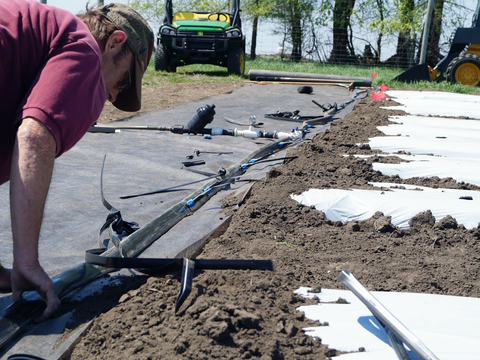Key points
- Irrigation is critical for successful strawberry production in the Upper Midwest.
- Growers can choose between drip tape and overhead sprinklers, or use a combination.
- There are pros and cons of each type of irrigation.
- Work with an experienced irrigation company to install and learn to use your new system.
- Overhead irrigation is also used for frost protection.
Good irrigation is efficient and accurate and avoids over- or under-application.
- Over-application wastes water, is expensive, and may lead to erosion and surface water or groundwater contamination.
- Under-application results in reduced yield or crop loss by making the plants water- and nutrient-stressed.
Nutrients are taken up from the soil via water.
The two main types of irrigation for strawberries are drip irrigation and overhead sprinklers. June-bearing strawberries can use either system, but day-neutral strawberries require drip irrigation.
When exploring irrigation systems and vendors, select a system that can monitor water delivery and soil moisture. An efficient system with moisture monitoring should apply appropriate water rates based on the plants’ growth stage and soil moisture. Consult with irrigation suppliers to compare systems and find one that works well for your farm.
Drip irrigation
Drip irrigation is the slow, even application of low-pressure water to soil and plants using plastic tubing (drip tape) placed directly on the soil surface, within the rooting zone.
Drip irrigation systems must be carefully designed and installed so that they operate with proper efficiency.
Install either one or two lines per row depending on your planting layout.
Your soil type (e.g. sandy loam, clay loam, etc.) impacts how water moves through it and will determine the type of emitters, tape, and pump you need. Coarser soils with larger amounts of sand drain quickly and allow limited sideways movement of water from the emitters; therefore, you may need more emitters per lateral line. Conversely, soils with a high clay content are more effective at the sideways movement of water and may need fewer emitters.
If laying drip tape before planting, avoid punctures by placing it carefully so that the tape is not directly in line with the planting rows.
Pros and cons of drip irrigation systems
| Pros | Cons |
|---|---|
| Uses less than half the water of overhead systems because it supplies water directly to the crop row. | Requires skilled management. |
| Lower disease incidence because foliage and fruit remain dry. | Filtration is necessary to prevent clogging. |
| Fewer weeds because water is supplied directly to crop rows. | Not ideal for perennial systems because drip tape can be damaged by equipment or freezing. |
| Allows for fine-tuned water control. | Drip tape cannot be reused. A new planting requires new drip tape. |
| Reduces soil erosion potential. | Cannot be used for frost protection. |
| Field work can continue during irrigation because aisles remain dry. | |
| Lower energy use due to reduced operating pressure and flow rates. | |
| Lower operating and labor costs because the system is often highly automated. | |
| Can incorporate fertilizers (organic or conventional) into irrigation water. |
Overhead sprinklers
Overhead sprinklers in strawberry fields are not the same as the large pivot irrigation systems used in row crop fields. The sprinklers in strawberries are vertical pipes (risers) arising 2 to 3 feet above the ground. Sprinkler heads at the top of the risers emit water in a large circular pattern.
A standard setup uses a 6-inch mainline followed by a 4-inch sprinkler line. Pipe configuration is commonly 60 feet between sprinkler lines and 40 feet between each sprinkler head. This equates to about 28 sprinkler heads per acre.
Overhead sprinklers are an extremely helpful tool for frost protection. For this reason, some growers install both systems — drip tape for routine watering, and overhead sprinklers for spring frost protection.
However, overhead sprinklers contribute to foliar diseases by depositing water droplets directly onto the leaves.
Pros and cons of overhead sprinkler irrigation systems
| Pros | Cons |
|---|---|
| Equipment is fairly simple and standard. | Uses a lot of water because water is applied to entire crop field rather than just the crop rows. |
| Simple to install and maintain. | Promotes weed growth since water is applied to entire field. |
| Most equipment can be used for many years. | Increases soil erosion potential. |
| Can be used for frost protection. | Field work must pause until irrigation cycle is complete and aisles have a chance to dry. |
| Disease incidence is potentially increased due to water on foliage and fruit. | |
| Less accurate water control. | |
| Higher energy use. |
Video: Strawberry Farming - Overhead Sprinklers for Irrigation and Frost Protection (03:51)
Deciding how much and when to irrigate
Strawberry plants require around 1 inch of water per week during establishment and 1 to 2 inches per week in production years.
Of course, these numbers will change somewhat depending on the soil type, as sandier soil does not retain water as much as heavier soils.
Temperature, cloud cover and plant growth rate all impact how quickly water is lost from the soil and the plants.
Use soil moisture sensors in the field to determine irrigation timing. Aim to maintain a level of soil moisture (50% field capacity) rather than inches per week. Moisture sensors take the guesswork out of estimating irrigation needs based on rainfall or how wet the soil feels and will help prevent over-watering.
As a rule of thumb, soil moisture in a strawberry field should not fall below 50% field capacity. Use the data from the moisture sensor in combination with weather data, to determine when you need supplemental irrigation.
Video: Soil Moisture Monitors for Strawberries (03:11)
For more information on irrigation scheduling methods, see Basics of irrigation scheduling.
Reviewed in 2021



